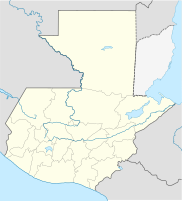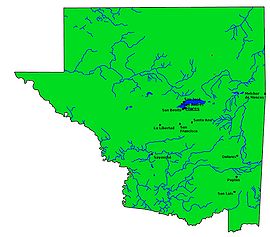Sayaxché
| Sayaxché | ||
|---|---|---|
|
Coordinates: 16 ° 32 ′ N , 90 ° 11 ′ W Sayaxché on the map of Guatemala
|
||
| Basic data | ||
| Country | Guatemala | |
| Department | Peten | |
| City foundation | 1874 | |
| Residents | 55,578 (2002) | |
| - in the metropolitan area | 7,322 | |
| Detailed data | ||
| surface | 3904 km 2 | |
| Population density | 14 people / km 2 | |
| height | 125 m | |
| Waters | numerous | |
| Post Code | 17010 | |
| Time zone | UTC −6 | |
| City patron | San Antonio de Padua (Festival: June 5th to 13th) | |
| Peténs map | ||
Sayaxché is a small town in Guatemala with a population of over 8,000 . Sayaxché is located in the Department of Peten and is the administrative seat of a municipality that extends over 3,904 km² and has over 60,000 inhabitants.
geography
Sayaxché is located in the southwest of Petén on the Río La Pasión at an altitude of 125 m. From Flores , the capital of the department Petén on Lake Petén-Itzá , the national road 5 leads via La Libertad and Sayaxché to Alta Verapaz further south . Sayaxché is about halfway, and both Flores and Alta Verapaz are around 70 km away.
As with all Municipios Peténs, the main town is located on a major traffic axis, while the administrative area extends far into the back, sparsely populated regions. The municipality of Sayaxché comprises the tropical lowlands in the south-west of Petén, rich in water. In the north and east it is bounded by the Río de la Pasión, in the west by the Río Salinas , whose numerous tributaries crisscross wide stretches of land. Among the lakes ("lagoons"), the Laguna Petexbatún, located about 10 km south of Sayaxché, with its swamps to the south is worth mentioning. This area with its famous Mayan ruins Aguateca and Dos Pilas has been placed under nature protection. In the vicinity of the main town Sayaxché are also the national parks El Rosario and Ceibal , the latter with the ruined city of the same name.
The neighboring municipalities are Las Cruces and La Libertad in the north, San Francisco in the northeast, Dolores in the east and San Luis in the southeast. Sayaxché borders the Alta Verapaz department to the south and the Mexican state of Chiapas to the west .
history
The numerous Mayan ruins in the area of the Municipios testify to the flourishing Mayan civilization . After its decline in the 8th century AD, the area remained largely deserted even after the Spanish Conquista . Sayaxché was founded in 1874 by forest workers from the Jamet Sastré company. Until the elevation to the municipality in 1929, the very remote place and its surroundings remained a " rural community " ( Aldea ) of the municipality of La Libertad. In the decades that followed, a gradual immigration of Kekchí from Alta Verapaz and then of people from all other parts of the country began. With the expansion of the national road 5 to Flores, Sayaxché soon grew into a small town and a trading and transport center in the south-west of Petén.
population
The population today consists of 65 percent Kekchí and 25 percent Ladinos , the remaining 10 percent are immigrant Maya of various ethnic groups from the highlands. 95 percent of the Kekchí live in the countryside. In addition to the main town Sayaxché, the municipality consists of eight rural communities and over 150 hamlets, some of which are very remote. The illiteracy rate is still very high among the population in the isolated rural settlements .
economy
Sayaxché lives mainly from agriculture, especially from the cultivation of corn , beans , rice , fruit and vegetables as well as from the production of spices and from cattle breeding . The forestry and timber industry is also important . The main town serves as a commercial and service center in the region. Because of the charming landscape and the rich Mayan cultural heritage, tourism also plays a role.
Mayan ruins
There are numerous Mayan ruins in the territory of the municipality, but not all of them are necessarily worth seeing. The most important archaeological sites include Cancuén, Jolomax, San Diego, Bonis, El Prado, La Reforma III, San Amelia, Tres Islas, La Flojera, Aguateca, Arroyo de Piedra, Anonal, Resbalón, Tamarindo, Punta Chimino, Las Pacayas, Dos Pilas, El Cedro, Altar de Sacrificio, El Chorro, Sayaxché, Ceibal, Aguas Calientes, El Caribe, Calatrava, La Amelia and San Juan Acul.
See also
Web links
- Official websites on inforpressca.com (span.)
- Extensive information on info.worldbank.org (Spanish, PDF, 1.65 MB)

